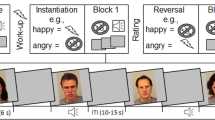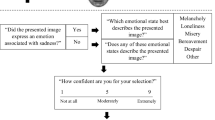Abstract
Emotional tears have been proposed to serve as a signal of distress, appeasement, and helplessness, which promotes prosocial responses in observers. They may also facilitate the perception of sadness. A still unanswered question is what information tears convey about emotional states when they are combined with different muscular facial expressions. The current study evaluated three hypotheses: Tears facilitate inferences about (a) emotion intensity in general (b) sadness in particular, or (c) helplessness-related appraisal and behavioral intentions. In the first experiment, participants viewed pictures of (non)tearful real and artificial faces displaying anger, disgust, fear, happiness, sadness, surprise, and neutral state. They had to report which of the seven expressions they recognized, and to rate its intensity, sincerity, and felt empathy. Tears appeared to facilitate the perception of sadness, but also of anger and fear, while they decreased the perception of disgust and surprise. The ratings of the intensity, the perceived sincerity, and the experienced empathy followed a similar pattern. In the second experiment, participants had to indicate if briefly (50 ms) presented (non)tearful faces showed a particular expression, and we measured their accuracy and reaction times. The results of the first experiment were not corroborated. Overall, the findings lend most support to the appraisal/behavioral intentions hypothesis and less support for the intensity and the sadness enhancement hypotheses.


Similar content being viewed by others
References
Aragón, O. R., & Bargh, J. A. (2018). “So Happy I Could Shout!” and “So Happy I Could Cry!” Dimorphous expressions represent and communicate motivational aspects of positive emotions. Cognition and Emotion, 32, 286–302.
Balsters, M. J. H., Krahmer, E. J., Swerts, M. G. J., & Vingerhoets, A. J. J. M. (2013). Emotional tears facilitate the recognition of sadness and the perceived need for social support. Evolutionary Psychology, 11, 148–158.
Barrett, L. F. (2006). Are emotions natural kinds? Perspectives on Psychological Science, 1, 28–58.
Barr-Zisowitz, C. (2000). “Sadness”—Is there such a thing? In M. Lewis & J. M. Haviland-Jones (Eds.), Handbook of emotions (2nd ed., pp. 607–622). New York: Guilford.
Berkowitz, L., & Harmon-Jones, E. (2004). Toward an understanding of the determinants of anger. Emotion, 4, 107–130.
Blais, C., Jack, R. E., Scheepers, C., Fiset, D., & Caldara, R. (2008). Culture shapes how we look at faces. PLoS ONE, 3, e3022. https://doi.org/10.1371/journal.pone.0003022.
Calvo, M. G., & Lundqvist, D. (2008). Facial expressions of emotion (KDEF): Identification under different display-duration conditions. Behavior Research Methods, 40, 109–115.
Carroll, J. M., & Russell, J. A. (1996). Do facial expressions signal specific emotions? Judging emotion from the face in context. Journal of Personality and Social Psychology, 70, 205–218.
Clore, G. L., & Ortony, A. (2008). Appraisal theories: How cognition shapes affect into emotion. In M. Lewis, J. M. Haviland-Jones, & L. F. Barrett (Eds.), Handbook of emotions (3rd ed., pp. 628–642). New York: Guilford.
Crile, G. W. (1915). The origin and nature of the emotions. Philadelphia: Saunders.
Darwin, C. (1872). The expression of emotions in animals and man (1998th ed.). New York: Oxford University Press.
De Deyne, S., Navarro, D. J., & Storms, G. (2012). Better explanations of lexical and semantic cognition using networks derived from continued rather than single-word associations. Behavior Research Methods, 45, 480–498.
Ekman, P. (1992). An argument for basic emotions. Cognition and Emotion, 6(3–4), 169–200.
Ekman, P., & Friesen, W. V. (1978). Manual of the Facial Action Coding System (FACS). Palo Alto, CA: Consulting Psychologists Press.
Ellsworth, P. C., & Smith, C. A. (1988). From appraisal to emotion: Differences among unpleasant feelings. Motivation and Emotion, 12, 271–302.
Faul, F., Erdfelder, E., Lang, A.-G., & Buchner, A. (2007). G*Power 3: A flexible statistical power analysis program for the social, behavioral, and biomedical sciences. Behavior Research Methods, 39, 175–191.
Fischer, A., & Giner-Sorolla, R. (2016). Contempt: Derogating others while keeping calm. Emotion Review. https://doi.org/10.1177/1754073915610439.
Frijda, N. H. (1986). The emotions. Cambridge: Cambridge University Press.
Gračanin, A., Bylsma, L., & Vingerhoets, A. J. J. M. (2018). Why only humans shed emotional tears: Evolutionary and cultural perspectives. Human Nature, 29, 104–133.
Hendriks, M. P., & Vingerhoets, A. J. J. M. (2006). Social messages of crying faces: Their influence on anticipated person perception, emotions, and behavioral responses. Cognition and Emotion, 20, 878–886.
Ito, K., Ong, C. W., & Kitada, R. (2019). Emotional tears communicate sadness but not excessive emotions without other contextual knowledge. Frontiers in Psychology. https://doi.org/10.3389/fpsyg.2019.00878.
Kottler, J. A., & Montgomery, M. J. (2001). Theories of crying. In A. J. J. Vingerhoets & R. R. Cornelius (Eds.), Adult crying: A biopsychosocial approach (pp. 1–17). Hove: Brunner-Routledge.
Küster, D. (2018). Social effects of tears and small pupils are mediated by felt sadness: An evolutionary view. Evolutionary Psychology, 16(1), 1474704918761104. https://doi.org/10.1177/1474704918761104.
Küster, D., Krumhuber, E. G., Steinert, L., Ahuja, A., Baker, M., & Schultz, T. (2020). Opportunities and challenges for using automatic human affect analysis in consumer research. Frontiers in Neuroscience, 14, 400. https://doi.org/10.3389/fnins.2020.00400.
Lundqvist, D., Flykt, A., & Öhman, A. (1998). The Karolinska Directed Emotional Faces—KDEF, CD ROM from Department of Clinical Neuroscience, Psychology Section, Karolinska Institutet, ISBN 91-630-7164-9.
Miceli, M., & Castelfranchi, C. (2003). Crying: Discussing its basic reasons and uses. New Ideas in Psychology, 21, 247–273.
Nelson, J. K. (2005). Seeing through tears: Crying and attachment. New York: Routledge.
Öhman, A. (2010). Fear and anxiety: Overlaps and dissociations. In M. Lewis, J. M. Haviland-Jones, & L. Feldman Barrett (Eds.), Handbook of emotions (pp. 709–729). New York: Guilford.
Ortony, A., Clore, G. L., & Collins, A. (1988). The cognitive structure of emotions. Cambridge: CUP.
Pantic, M., & Rothkrantz, L. J. M. (2000). Expert system for automatic analysis of facial expressions. Image and Vision Computing, 18, 881–905.
Picó, A., Gračanin, A., Gadea, M., Boeren, A., Aliño, M., & Vingerhoets, A. J. J. M. (2020). How visible tears affect observers’ judgements and behavioral intentions: Sincerity, remorse, and punishment. Journal of Nonverbal Behavior, 44, 215–232.
Provine, R. R. (2012). Curious behavior. Yawning, laughing, hiccupping and beyond. Belknap: Cambridge.
Provine, R. R., Krosnowski, K. A., & Brocato, N. W. (2009). Tearing: Breakthrough in human emotional signaling. Evolutionary Psychology, 7, 52–56.
Reed, L. I., Deutchman, P., & Schmidt, K. L. (2015). Effects of tearing on the perception of facial expressions of emotion. Evolutionary Psychology. https://doi.org/10.1177/1474704915613915.
Rigoulot, S., & Pell, M. D. (2015). Emotion in the voice influences the way we scan emotional faces. Speech Communication, 65, 36–49.
Russell, J. A., & Barrett, L. F. (1999). Core affect, prototypical emotional episodes, and other things called emotion: Dissecting the elephant. Journal of Personality and Social Psychology, 76, 805–819.
Scherer, K. R. (1984). On the nature and function of emotion: A component process approach. In K. R. Scherer & P. Ekman (Eds.), Approaches to emotion (pp. 293–317). Hillsdale, NJ: Erlbaum.
Scherer, K. R., Mortillaro, M., & Mehu, M. (2017). Facial expression is driven by appraisal and generates appraisal inference. In J. A. Russel & J. M. Fernandez Dols (Eds.), The science of facial expression (pp. 353–373). New York: OUP.
Seidel, E. M., Habel, U., Kirschner, M., Gur, R. C., & Derntl, B. (2010). The impact of facial emotional expressions on behavioral tendencies in women and men. Journal of Experimental Psychology: Human Perception and Performance, 36, 500–507.
Todorov, A., Pakrashi, M., & Oosterhof, N. N. (2009). Evaluating faces on trustworthiness after minimal time exposure. Social Cognition, 27, 813–833.
Van den Stock, J., Righart, R., & de Gelder, B. (2007). Body expressions influence recognition of emotions in the face and voice. Emotion, 7, 487–494.
Vingerhoets, A. J. J. M. (2013). Why only humans weep: Unraveling the mysteries of tears. Oxford: Oxford University Press.
Vingerhoets, A. J. J. M., & Bylsma, L. M. (2016). The riddle of human emotional crying: A challenge for emotion researchers. Emotion Review, 8, 207–217.
Vingerhoets, A. J. J. M., van de Ven, N., & van der Velden, Y. (2016). The social impact of emotional tears. Motivation and Emotion, 40, 455–463.
Vingerhoets, A. J. J. M., van Geleuken, A. J. M. L., van Tilburg, M. A. L., & van Heck, G. L. (1997). The psychological context of crying episodes: Towards a model of adult crying. In A. J. J. M. Vingerhoets, F. van Bussel, & A. Boelhouwer (Eds.), The (non)expression of emotions in health and disease (pp. 323–336). Tilburg: TUP.
Zeifman, D. M., & Brown, S. A. (2011). Age-related changes in the signal value of tears. Evolutionary Psychology, 9, 313–324.
Acknowledgements
We greatly appreciate the efforts of Femke van Geffen, Sebastian M. Merino-Norambuena, Marjolein N. M. Smits, and Ruben D. Vromans for their help in data collection in Study 1, and Martijn B. Goudbeek for providing us with valuable comments on potential statistical solutions.
Funding
This work was supported by the NEWFELPRO fund under Grant No. 32 and UNIRI Grant 17.05.2.1.03.
Author information
Authors and Affiliations
Corresponding author
Additional information
Publisher's Note
Springer Nature remains neutral with regard to jurisdictional claims in published maps and institutional affiliations.
Electronic supplementary material
Below is the link to the electronic supplementary material.
Rights and permissions
About this article
Cite this article
Gračanin, A., Krahmer, E., Balsters, M. et al. How Weeping Influences the Perception of Facial Expressions: The Signal Value of Tears. J Nonverbal Behav 45, 83–105 (2021). https://doi.org/10.1007/s10919-020-00347-x
Accepted:
Published:
Issue Date:
DOI: https://doi.org/10.1007/s10919-020-00347-x




